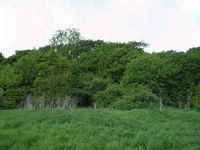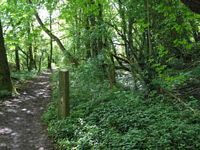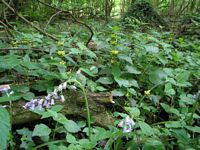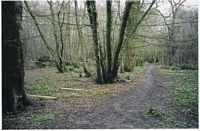Gallery
Hartley Wood is some 60 acres in extent and lies to the east of Gorsewood Road and west of Hartley Bottom Road. The trees are mainly a mixture of hornbeam, beech and oak. It is several hundred years old, and up until recently would have been commercially managed, as is evident by the coppicing of many of the trees. There is a strong probability that the wood was used in the charcoal making industry in the 17th century.
It used to belong to Hartley Court, and like much of Hartley was purchased by Small Owners Ltd in 1913. The part nearer Gorsewood Road came into the hands of the Fawkham Development Company in 1934. They sold the land off in plots and planned an estate road from the bottom of Gorsewood Road with access "for all purposes". We understand that one plot owner has successfully argued for their right of access there. Thus this part of the wood has many owners - some known, some not. A large part does belong to Gorsewood Farm.
The eastern part of the wood is owned by the London Borough of Southwark. The reason is connected with the former rubbish dump by the railway, which was purchased by their predecessor council (Newington Vestry) in 1874. Although it appears they may have purchased the wood later from Small Owners.
Attempts to Buy the Southwark Land
From about 1995 to 1998, there were protracted attempts by the Woodland Trust to purchase the part of the wood owned by Southwark. This foundered on the issue of liability for any pollution from the adjoining former tip. No doubt thinking of their ratepayers, Southwark asked for an indemnity against being sued which the Woodland Trust wouldn't agree to. It has been said that Southwark were mistaken in law on this point. In the end the Woodland Trust chose to walk away and refund local residents' money. It is understood that they would not be interested again.
The Village Green Application
Around July 2005 Hartley Parish Council applied to Kent County Council to register the land owned by Southwark as a "village green". This was not officially taken in until 12 October 2005 because of some defect in the application. The parish council have chosen only to apply for this part of the wood.
To make land a village green, you have to prove that for at least 20 years the residents of the neighbourhood have been using the land for lawful games and pastimes. Importantly the use must not be in secret, by force or by permission. Hartley Parish Council have got a number of sworn statements called "statutory declarations" of 20 years' use, but discussions in council meetings suggest there are a number of other issues involved concerning when the land was fenced, leaflets issued by Southwark in the 1980s and the Woodland Trust application. These applications are seldom cut and dried, the people of Hartley thought they had a good case when they applied to make Rectory Meadow a village green some years ago, but were unsuccessful.
If successful the landowner still retains ownership but this right is to a large extent not worth having, because they can do nothing with the land to prevent access, and will be burdened with public liability issues. On the other hand a successful claim means the local community will enjoy access in perpetuity.
When they received notice, Southwark (not surprisingly) objected and put up notices and fence posts. These have been subject to criminal damage by persons unknown. Fencing the land is not an unusual action by the landowner in these cases, which is why such applications are often only made when the right to use the land is challenged, which was not the case here.
There has been a recent court case (Feb 2005) in Oxford where the Appeal Court said that a landowner could defeat a claim by fencing the land before it was registered as a green. In March 2005 the Open Spaces Society said "the judgement is an open invitation to landowners to challenge use once they know an application has been made, and thereby to thwart registration". Notwithstanding this the parish council applied in July and then appeared surprised when Southwark reacted as predicted.
However this judgement has just been overturned by the House of Lords, so the application will now be considered again on its merits. There is no set procedure, but is customary for the county council to hold a public enquiry in these cases.




